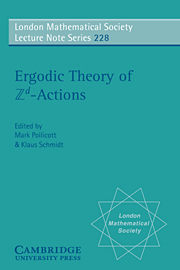Book contents
- Frontmatter
- Contents
- Introduction
- Surveys
- 1 Ergodic Ramsey Theory
- 2 Flows on homogeneous spaces
- 3 The variational principle for Hausdorff dimension
- 4 Boundaries of invariant Markov Operators: The identification problem
- 5 Squaring and cubing the circle – Rudolph's theorem
- 6 A survey of recent K-theoretic invariants for dynamical systems
- 7 Miles of Tiles
- 8 Overlapping cylinders: the size of a dynamically defined Cantor-set
- Research Papers
4 - Boundaries of invariant Markov Operators: The identification problem
Published online by Cambridge University Press: 30 March 2010
- Frontmatter
- Contents
- Introduction
- Surveys
- 1 Ergodic Ramsey Theory
- 2 Flows on homogeneous spaces
- 3 The variational principle for Hausdorff dimension
- 4 Boundaries of invariant Markov Operators: The identification problem
- 5 Squaring and cubing the circle – Rudolph's theorem
- 6 A survey of recent K-theoretic invariants for dynamical systems
- 7 Miles of Tiles
- 8 Overlapping cylinders: the size of a dynamically defined Cantor-set
- Research Papers
Summary
Initially this paper was conceived as a short appendix to the recent article of Olshanetsky [Ol2] on the Martin boundary of symmetric spaces (which appeared nearly 25 years after the first research announcement [Ol1]), and was supposed to provide the reader with a background information about what was going on in the area during all that time. A preliminary version was circulated in 1993 under the title “An introduction to boundary theory of invariant Markov operators”. Alas, soon it outgrew any reasonable limits for such an appendix, so that instead I decided to make of it a separate survey of the development of the boundary theory of invariant Markov operators on groups and homogeneous spaces during the last 2-3 decades (preserving, however, a special section devoted to boundaries of symmetric spaces, semi-simple Lie groups and their discrete subgroups). Still, trying to keep the survey as brief as possible, I had to omit a (rather large) number of topics closely connected with the boundary theory (ergodic properties and singularity of the harmonic measure with respect to other natural boundary measures; connections with such numerical characteristics as the spectral radius, growth, the rate of escape and the Hausdorff dimension of the harmonic measure; harmonic invariant measures of the geodesic flow, etc.). My intention was to concentrate on general ideas and methods used for describing the Martin boundary and its probabilistic counterpart – the Poisson boundary.
- Type
- Chapter
- Information
- Ergodic Theory and Zd Actions , pp. 127 - 176Publisher: Cambridge University PressPrint publication year: 1996
- 6
- Cited by

